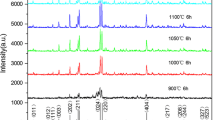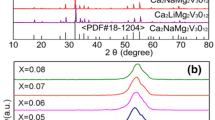Abstract
The emission of Mn2+ in an orange hue within cation-disordered optical materials, consisting of Ba6CaNaYAl2Si6O24:Eu2+, Mn2+, was significantly enhanced through efficient energy transfer, when compared to the performance of Eu2+, Mn2+-doped Ba6Ca3Al2Si6O24 phosphors. The degree of polyhedral distortions within the Ba6CaNaYAl2Si6O24 structure was ascertained using synchrotron X-ray powder diffraction. The cation-disordered host structure incorporates 12-, 9-, and 10-coordinated polyhedra involving Ba(I), Ca/Y(II), and Ba/Na(III) ions, along with AlO6 octahedra and isolated SiO4 tetrahedra. Photoluminescence emission spectra of the cation-disordered Ba5.9-qEu0.1MnqCaNaYAl2Si6O24 (q = 0–0.4) phosphors were examined, along with the energy-transfer process from Eu2+ to Mn2+ according to Förster’s theory, both occurring under 365-nm excitation. White and orange electroluminescent emission spectra, color rendering index, correlated color temperature, Commission Internationale de l’Eclairage coordinates, and internal/external quantum efficiency were measured for Ba5.5Eu0.1Mn0.2CaNaYAl2Si6O24 phosphors, both with and without commercial phosphors on a 365-nm LED chip. Moreover, the activation energy of thermal quenching for Ba5.9-q-Eu0.1MnqCaNaYAl2Si6O24 (q = 0.2, 0.4) phosphors within the temperature range of 298–448 K was determined when illuminated by a 365-nm light-emitting diode (LED).








Similar content being viewed by others
Data availability
The authors state that data supporting this study in the manuscript are available on reasonable request.
References
G.B. Naira, H.C. Swarta, S.J. Dhoble, A review on the advancements in phosphor-converted light emitting diodes (pc-LEDs): phosphor synthesis, device fabrication and characterization. Prog. Mater. Sci. 109, 100622 (2020)
J. McKittrick, L.E. Shea-Rohwer, Review: down conversion materials for solid-state lighting. J. Am. Ceram. Soc. 97, 1327–1352 (2014)
S. Ye, F. Xiao, Y.X. Parn, Y.Y. Ma, Q.Y. Zhang, Phosphors in phosphor-converted white light-emitting diodes: recent advances in materials, techniques and properties. Mater. Sci. Eng. R 71, 1–34 (2010)
J. Ueda, S. Tanabe, Review of luminescent properties of Ce3+-doped garnet phosphors: new insight into the effect of crystal and electronic structure. Opt. Mater. X 1, 100018 (2019)
Z. Xia, A. Meijerink, Ce3+-Doped garnet phosphors: composition modification, luminescence properties and applications. Chem. Soc. Rev. 46, 275–299 (2017)
S. Yang, S. Park, Luminescent performances of Ba9-pCapAl2Si6O24:Eu2+, Mn2+ orthosilicate phosphors along with Ca2+ contents. Opt. Mater. 114, 110968 (2021)
Z. Sun, Z. Zhu, J. Luo, Z. Guo, X. Zhang, Z.-C. Wu, High-efficient and thermal-stable Ca19Zn2(PO4)14:Eu2+, Mn2+ blue-red dual-emitting phosphor for plant cultivation LEDs. J. Alloys Compd. 811, 151956 (2019)
Q. Zhang, J. Li, W. Jiang, L. Lin, J. Ding, M.G. Brik, M.S. Molokeev, H. Ni, M. Wu, CaY2Al4SiO12:Ce3+, Mn2+: a single component phosphor to produce high color rendering index WLEDs with a blue chip. J. Mater. Chem. C 9, 11292 (2021)
D. Pasiński, E. Zych, J. Sokolnicki, Ce3+ to Mn2+ energy transfer in Sr3Y2Ge3O12:Ce3+, Mn2+ garnet phosphor. J. Alloy Compds. 653, 636–642 (2015)
Q. Zhou, L. Dolgov, A.M. Srivastava, L. Zhou, Z. Wang, J. Shi, M.D. Dramićann, M.G. Brik, M. Wu, Mn2+ and Mn4+ red phosphors: synthesis, luminescence and applications in WLEDs. A review. J. Mater. Chem. C 6, 2652–2671 (2018)
C.C. Lin, Y.-T. Tsai, H.E. Johnston, M.-H. Fang, F. Yu, W. Zhou, P. Whitfield, Y. Li, J. Wang, R.-S. Liu, J.P. Attfield, Enhanced photoluminescence emission and thermal stability from introduced cation disorder in phosphors. J. Am. Chem. Soc. 139, 11766–11770 (2017)
Y. Kim, S. Park, Preparation and luminescent properties of Eu-substituted barium–yttrium orthosilicate phosphors. Opt. Mater. 36, 458–462 (2013)
S. Shin, S. Yang, S.-H. Lee, T.J. Shin, S. Park, Distinctive occurrences of green-yellow luminescence from orthogermanate-type Ba9Y2(GeO4)6:Ce3+, Na+ phosphors under blue excitation and white-light performance with light-emitting diodes. J. Alloys Compds. 897, 163213 (2022)
F. Lin, X. Li, C. Chen, X. Pan, D. Peng, H. Luo, L. Jin, Y. Zhuang, R.J. Xie, Modeling polyhedron distortion for mechanoluminescence in mixed-anion compounds RE2O3S:Ln3+. Chem. Mater. 34, 5311–5319 (2022)
M. Chen, Z. Xia, M.S. Molokeev, T. Wang, Q. Liu, Tuning of photoluminescence and local structures of substituted cations in xSr2Ca(PO4)2-(1–x)Ca10Li(PO4)7:Eu2+ phosphors. Chem. Mater. 29, 1430–1438 (2017)
S. Shin, S. Park, Color-tunable Bi3+–Tb3+–Eu3+ co-activated barium–yttrium-orthogermanate phosphors for applying white-light UV-LED. J. Mater. Sci. 34, 287 (2023)
D.L. Dexter, A theory of sensitizer luminescence in solids. J. Chem. Phys. 21, 836–850 (1953)
T.-M. Chen, Y.-J. Yang, Phosphors, Up Conversion Nanoparticles, Quantum Dots and Their Applications (Springer, Berlin, 2017), pp.31–53
W.R. Liu, C.H. Huang, C.W. Yeh, J.C. Tsai, Y.C. Chiu, Y.T. Yeh, A study on the luminescence and energy transfer of single-phase and color-tunable KCaY(PO4)2:Eu2+, Mn2+ phosphor for application in white-light LEDs. Inorg. Chem. 51, 9636–9641 (2012)
W.J. Yang, L. Luo, T.-M. Chen, N.-S. Wang, Luminescence and energy transfer of Eu- and Mn-coactivated CaAl2Si2O8 as a potential phosphor for white-light UVLED. Chem. Mater. 17, 3883–3888 (2005)
E. Gökoğlu, E. Yilmaz, Fluorescence interaction and determination of sulfathiazole with trypsin. J. Fluoresc. 24, 1439–1445 (2014)
A. Krishnan, T.S. Sreeremya, A.P. Mohamed, U.S. Hareesh, S. Ghosh, Concentration quenching in cerium oxide dispersions via a Förster resonance energy transfer mechanism facilitates the identification of fatty acids. RSC Adv. 5, 23965–23972 (2015)
J. Huo, A. Yu, Q. Ni, D. Guo, J. Gao, Y. Zhang, Q. Wang, Efficient energy transfer from trap levels to Eu3+ leads to antithermal quenching effect in high-power white light-emitting diodes. Inorg. Chem. 59, 15514–15525 (2020)
W.-W. Hu, W.-W. Ji, S.A. Khan, L.U. Hao, X. Xu, L.-J. Yin, S. Agathopoulos, Preparation of Sr1-xCaxLiAl3N4:Eu2+ solid solutions and their photoluminescence properties. J. Am. Ceram. Soc. 99, 3273–3279 (2016)
J. Ni, Q. Liu, Z. Zhou, G. Liu, Co-doping effect of Mn2+ on fluorescence thermosstability of Ca-a-sialon:Eu2+ phosphors. RSC Adv. 7, 42211–42217 (2017)
J. Cui, Y. Zheng, Z. Wang, L. Cao, X. Wang, Y. Yao, M. Zhang, Z. Yang, P. Li, Improving the luminescence thermal stability of Ca3Y2Ge3O12:Cr3+ based on cation substitution and its application in NIR LEDs. Mater. Adv. 3, 2772–2778 (2022)
Acknowledgements
This research was supported by Basic Science Research Program through the National Research Foundation of Korea (NRF) funded by the ministry of Education, Science and Technology (NRF-2018R1D1A3B07048543).
Funding
Funding was provided by National Research Foundation of Korea (NRF) (Grant no. NRF-2018R1D1A3B07048543).
Author information
Authors and Affiliations
Contributions
SP: Supervision, Conceptualization, Methodology, Writing, Reviewing and Editing. HH: Synthesis, Data curation, Software, Writing-original draft. SY: Data curation, Software, Writing-original draft.
Corresponding author
Ethics declarations
Conflict of interest
The authors declare that they have no known competing financial interests or personal relationships that could have appeared to influence the work reported in this paper.
Additional information
Publisher's Note
Springer Nature remains neutral with regard to jurisdictional claims in published maps and institutional affiliations.
Rights and permissions
Springer Nature or its licensor (e.g. a society or other partner) holds exclusive rights to this article under a publishing agreement with the author(s) or other rightsholder(s); author self-archiving of the accepted manuscript version of this article is solely governed by the terms of such publishing agreement and applicable law.
About this article
Cite this article
Ha, H., Yang, S. & Park, S. Enhanced Mn2+ emission from cation disordered substitution in Ba6CaNaYAl2Si6O24:Eu2+, Mn2+ phosphors. J Mater Sci: Mater Electron 35, 343 (2024). https://doi.org/10.1007/s10854-024-12091-9
Received:
Accepted:
Published:
DOI: https://doi.org/10.1007/s10854-024-12091-9




